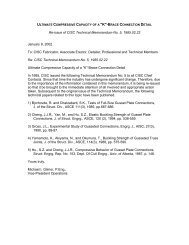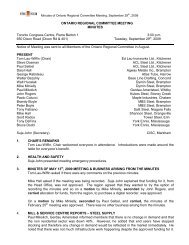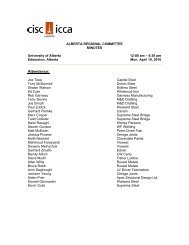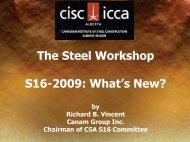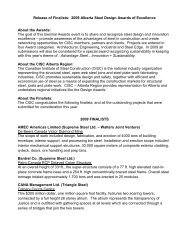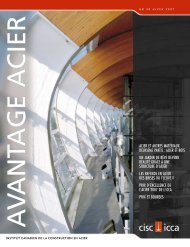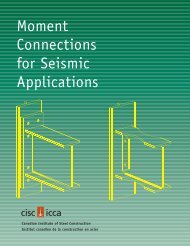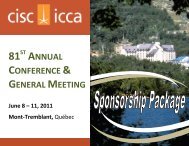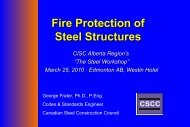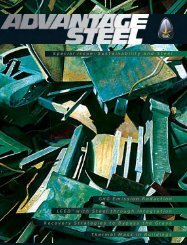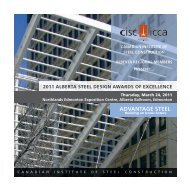FIRE PROTECTION OF STEEL STRUCTURES ... - CISC-ICCA
FIRE PROTECTION OF STEEL STRUCTURES ... - CISC-ICCA
FIRE PROTECTION OF STEEL STRUCTURES ... - CISC-ICCA
You also want an ePaper? Increase the reach of your titles
YUMPU automatically turns print PDFs into web optimized ePapers that Google loves.
called Fire Dynamics Simulator, which was developed by the<br />
National Institute of Standards and Technology in the United<br />
States and is categorized as a computational fluid dynamics field<br />
model. The model also represents the compartment’s associated<br />
physical properties such as geometry, ventilation, finish, etc.<br />
Output from the model simulations provide relevant information<br />
such as ceiling jet temperatures, fuel burning rates, heat flux on<br />
enclosure boundaries and sprinkler activation times. The data<br />
was used in traditional heat calculation methods to determine the<br />
structural response of the exposed structural steel assemblies.<br />
The Fire Protection Engineer involved in a PBD of a building’s fire<br />
protection can use a range of computer models. A useful website<br />
with an international survey conducted on a range of computer<br />
models for fire and smoke is www.firemodelsurvey.com. The<br />
site lists 168 computer fire and smoke models in six categories:<br />
fire endurance, egress, detector response, zone, field<br />
and miscellaneous.<br />
There has also been a development in a set of sophisticated C<br />
codes of practice for the fire design of structures, namely<br />
M<br />
Eurocodes. Eurocodes apply to the common building materials<br />
Y<br />
of concrete, steel, composite steel-concrete, timber, masonry<br />
CM<br />
and aluminum. For steel structures, the code is EN 1993-1-<br />
2:2005, Eurocode 3: Design of Steel Structures, Part 1-2: MY<br />
General rules -- Structural Fire Design. The provisions in<br />
CY<br />
Eurocode 3 for steel structures and fire deal with the complexity<br />
CMY<br />
of internal forces induced by thermal expansion, strength<br />
K<br />
reduction due to elevated temperatures, the associated<br />
amplified deflections and other design factors (the document’s<br />
technical content is over 80 pages). Similar engineering<br />
guidance in North America has recently been published by<br />
both AISC and CSA, i.e., ANSI/AISC 360-05’s Appendix 4<br />
and CSA S16-09’s Annex K, entitled Structural Design For Fire<br />
Conditions, which provide an aid for structural engineers to<br />
develop PBD fire safety for buildings designed with structural<br />
steel. The provisions in ANSI/AISC 360-05 and CSA S16-09<br />
FiRE PROtEctiON<br />
“There are many examples where a PBD approach has led to steel components<br />
in the building structure being designed to be unprotected or with a significant<br />
reduction in fire protection materials”<br />
appendix/annex are general introductory guidelines (about<br />
10 pages) to orient a structural engineer in performance-based<br />
fire engineering, a skill that, for the most part, is unfamiliar<br />
territory for the profession. This is an exciting advance because<br />
it opens the door to new design possibilities once the team has<br />
demonstrated that the alternative meets the fire safety levels<br />
required by the Code without adopting all of the prescriptive<br />
Code provisions.<br />
JLD036_WMSC_<strong>CISC</strong>qt.pdf 1 10-12-15 2:03 PM<br />
S P R I N G 2 0 1 1 A D V A N T A G E S T E E L 1 9




